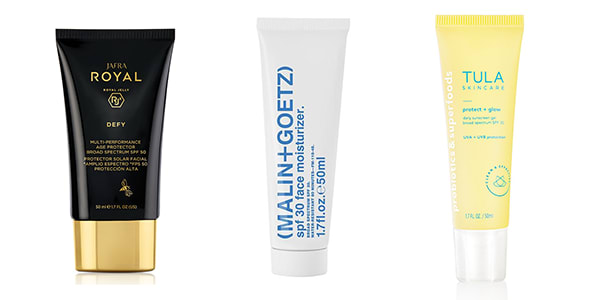 Non-Ablative Fractional Laser Skin Resurfacing
Non-Ablative Fractional Laser Skin ResurfacingSo, What’s The Difference Between Chemical And Physical Sunscreen?
Whether you are a sunscreen savant or are looking to up your SPF game, one of the most important things to know about your sun protection is how it works.
According to a recent survey by the American Academy of Dermatology (AAD), 76 percent of Americans agree that sunscreen is important — yet only about 40 percent of them admit to regularly using sun protection outdoors. When you consider that exposure to the sun’s damaging UV rays is the most preventable risk factor for skin cancer, sunscreen is a non-negotiable.
First things first: the weather forecast should not dictate sunscreen usage. “Sunscreen is an absolute must — not just when sipping a pina colada poolside,” says Beverly Hills board certified dermatologist Ava Shamban, MD. It is an everyday affair and should be a staple in every skincare routine. While most people associate sun protection with spending time outdoors or the dog days of summer, it is just as important to be wearing sunscreen when you are working from home (or the office), stuck in traffic, or running errands.
Whether you are someone who is already committed to protecting your skin from damage or are looking to up your SPF game, one of the most important things to know about your sun protection is how it works. That is determined by whether the formula is a chemical or physical sunscreen.
So, what’s the difference between the two? The AEDITION asked the experts to break down the nitty gritty of what differentiates chemical and physical sunscreen formulas, the most common ingredients in each, and how to use them.
Chemical Sunscreen
“Chemical sunscreens use chemicals to absorb UV light rays,” explains Mona Gohara, MD, Connecticut-based board certified dermatologist. As such, these should be applied 30 minutes prior to going outside, so that the sunscreen can be properly “activated,” she says.
Chemical Sunscreen Ingredients
Chemical sunscreens typically include a combination of at least two of the following active ingredients:
- Oxybenzone
- Avobenzone
- Octisalate
- Octocrylene
- Homosalate
- Octinoxate
Chemical sunscreens are not without controversy. While the ingredients listed above are all effective in protecting the skin from damaging UVA and UVB rays, the United States Food and Drug Administration (FDA) is currently investigating the safety of these actives when absorbed by the skin. A recent study published in the Journal of the American Medical Association (JAMA) found that the active ingredients were “systemically absorbed” into participants’ skin and detected in blood plasma, urine, and breast milk after use. While these findings do not indicate that individuals should refrain from the use of chemical sunscreen, further research is needed. Additionally, sunscreens made with oxybenzone and octinoxate are prohibited from being sold in Hawaii, as they negatively affect coral reefs
Chemical Sunscreens to Try
Generally considered easier to apply than their physical counterparts, there are many innovative chemical sunscreens on the market.

Looking for a chemical formula with anti-aging benefits and a high SPF? Opt for Jafra Royal Jelly Defy SPF 50, which contains soybean extract, vitamin E, and royal jelly for softer skin. A good vegan option is Malin + Goetz SPF 30 Face Moisturizer. It includes vitamin E and aloe for added hydration. The new Tula Protect + Glow Daily Sunscreen Gel Broad Spectrum SPF 30, meanwhile, boasts a fast-absorbing gel formula that also shields skin from blue light.
Physical Sunscreen
Physical sunscreens (a.k.a. mineral sunscreens) are minerals that deflect the UV rays from the skin. Unlike chemical sunscreens that need to be applied in advance, physical sunscreens can be applied immediately before exposure to the sun. “[Physical sunscreens] are inert and sit on skin to cause a shield to physically block and protect the dermis from UVA and UVB rays,” Dr. Shamban explains, adding that they are naturally occurring minerals that will not cause any harm to the skin. “They are designated as the safest for all usages by the FDA,” she says.
While it may be easy to describe chemical formulas as ‘sunscreen’ and physical ones as ‘sunblock,’ such a classification oversimplifies the technology. “Mineral filters have scattering and reflective properties, but it is not because of these properties that they become effective sunscreens,” says Dr. Terry Zickerman, founder of sun care brand Love Sun Body. Instead, physical sunscreens work because of their semiconductor-like electronic properties as solids, which means they both block and absorb UV rays. But there is still a key difference between chemical and physical sunscreens. “The physical/mineral filters are not absorbed into the skin,” he says. “Mineral filters will wash off.”
Physical Sunscreen Ingredients
The most common active ingredients in physical sunscreens are:
- Titanium dioxide
- Zinc oxide
- Iron oxide
As Dr. Gohara explains, the FDA regards that trio as safe and effective. While your zinc associations may involve lifeguards with bright white noses, modern mineral-based formulas have come a long way. “[They] are now usually formulated in a micronized fashion for better coverage and less chalky appearance.” Dr. Shamban says. While titanium dioxide is ideal for sensitive skin, she cautions that such formulas are still known for their “thicker consistency” — though some of the newer options consist of nanoparticles that make the products easier to use.
Physical Sunscreens to Try
Sun protection factor (SPF) is the most important element of any sunscreen, but how it wears on the skin is equally vital for compliance. Since mineral sunscreens can leave skin (especially darker complexions) ashy, Dr. Shamban prefers micro fluids, as they spread well and yield great coverage. She recommends Coola, ISDIN Eryfotona, and La Roche Posay Anthelios. If you are looking for a makeup-suncare hybrid, the IT Cosmetics CC+ Cream with SPF 50+ is one of the few foundations that contain a physical (not chemical) sunscreen.

And there is plenty more where that came from. Available in both TSA friendly and full sizes, Love Sun Body Natural Origin Mineral sunscreens can be used on the face and body and come in SPF 30 and SPF 50 options. For dry or sensitive skin, Neogen Day Light Protection SPF 50+ is an excellent choice that also is fragrance-free. To keep the delicate eye area protected while imparting a hint of color, Supergoop Shimmerhade Illuminating Cream Eyeshadow comes in a variety of hues and features SPF 30. Launched last year, the radiant pots topped our list of innovative sunscreens in 2019.
How to Apply Sunscreen
“Both chemical and mineral sunscreens can be very cosmetically elegant,” Dr. Gohara says. She personally applies an SPF-spiked moisturizer in the morning and then touches up throughout the day with a portable mineral powder (we’re fans of the Colorescience Sunforgettable Total Protection Brush-On Shield SPF 50). “I love the sprays for the body,” she says. “It is less messy and makes it easy for the whole family to apply.” She advises rubbing the formula in to be sure you didn't miss any spots.
With either a chemical or physical formula, you want to reapply a minimum of every two hours or after swimming and/or sweating (whichever comes first). Dr. Gohara recommends using a shot glass-sized amount for the body and a nickel-sized amount on the face. “Use a powder for the scalp and stick around the eyes, so it doesn’t get in your eyes and sting,” she adds. Oh, and don’t forget your ears, scalp, lips, and tops of feet. They are some of the commonly burned areas.
For the most seamless mineral sunscreen application, Dr. Zickerman suggests working in small sections. Squirt a dollop of the formula into the palm and “warm it by rubbing both hands together in a circular motion,” he says. Once it’s warmed up, start applying. While it may take a couple of extra minutes, he says it yields the best result. Another tip? Put your sunscreen on straight out the shower (after toweling dry, of course). “Your skin will be warm and will help warm the formula,” he says, adding that any faint whiteness should dissipate in three to five minutes.
The Takeaway
While you may be tempted to streamline your suncare routine with multitasking formulas, Dr. Shamban warns that moisturizers with SPF and makeup with sunscreen do not offer adequate protection. Ideally, sunscreen should be applied as your last step before makeup. “Even when makeup has a good mineral compound for a 30 SPF or higher, no one usually puts on enough makeup to get the full benefit needed,” she explains. While a standalone sunscreen with an SPF of at least 30 is recommended, don’t let the number fool you. “A higher number does not mean you don't need to reapply,” Dr. Shamban reminds us — so, be sure to keep a powder or mist formula handy for touch ups.
All products featured are independently selected by our editors, however, AEDIT may receive a commission on items purchased through our links.
More Related Articles
Related Procedures

AI Plastic Surgeon™
powered by'Try on' aesthetic procedures and instantly visualize possible results with The AI Plastic Surgeon, our patented 3D aesthetic simulator.
